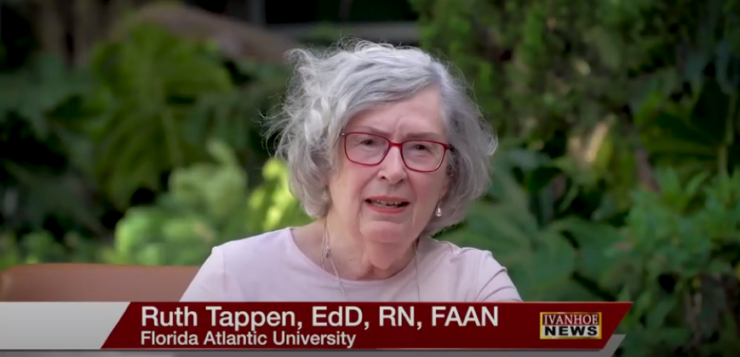Ruth Tappen, EDD, RN, FAAN, Emiment Scholar and Professor, Christine E. Lynn College of Nursing, Florida Atlantic University, and a member of the American Academy of Nursing, talks about driving with dementia and catching early brain changes.
Can you give us a little background on dementia? When someone is diagnosed and they’re still driving, what kind of risk does that pose?
TAPPEN: Most older people are partially aware that they’re having problems with driving and really do curb their driving. They may stop driving at night or only drive to familiar places. When dementia really takes hold, even getting from home to the grocery store can result in getting lost. They can even have trouble finding their car in the parking lot. That’s when the dementia has moved along and is at least in the moderate stage. Other mistakes that people with dementia make when they’re driving are left turns. You have to judge the distance and how fast the cars are going that are coming at you, which is difficult. Dementia affects not just memory, but all the functions of the brain. We all think we’re alert when we’re considering making a left-hand turn, but it’s difficult. The judgment about red lights and green lights sometimes gets mixed up. One man who had dementia told us he was a traveling salesman. He stayed overnight in many hotels all around the state. He finished his day and was going to head home and realized he didn’t know where he was and didn’t know how to get home. So, he went to the nearest hotel, checked in, stayed overnight, got up in the morning, got out his GPS figured out his route and got home. He never drove again and said that was just so frightening.
Are there any stats or numbers to say that more people with dementia tend to experience this more often?
TAPPEN: I don’t know if I can give you stats because what we know is from studies that have been done on how they drive. The accident data, which everybody thinks is going to be so much higher, is not because a lot of people do the responsible thing. The accidents that appear on television in a news clip involved those who did not or that didn’t realize they were having so much trouble. So, I would say most of them have cut back and made that change on their own or with the urging of family. There’s an interesting little tidbit we learned in talking with so many people who tell us that it’s very hard to convince a person to stop driving. It’s more often men, but it includes women as well. If you say, you might get hurt, you might be in an accident, that doesn’t persuade them to stop. But if you say, you might hurt somebody, you might hit somebody, your grandchildren in the back of the car could get hurt, that will persuade them much more effectively because they don’t want to hurt other people.
Are there certain guidelines, criteria, or test that people can take to help them in deciding it’s time to stop driving?
TAPPEN: We don’t have a quick test, but we have a second study supported by the state that’s called Fit to Drive. This includes very short cognitive tests. A lot of them are five minutes or less. We can predict with 80 percent accuracy but that’s not good enough. We want to be able to predict up in the 90 to 95 percent range whether or not you can pass an “on the road” test. the on road test itself takes 45 minutes and there’s a charge for it. Many people do choose to do that. We have people who are sent not only by their physicians or brought by their families, but by the court sometimes to see whether they’re really safe on the road.
Is this just a test in Florida or where can they access it?
TAPPEN: Oh, no. It’s available around the country, but not widely available. I think more and more memory centers like the one we have offer it and some universities offer it.
Talk to me a little bit about the study that you are conducting. How did the idea of it come about and what’s the need that you are addressing?
TAPPEN: It’s called “In-vehicle sensors to detect cognitive change in older adults.” I think of it as a brand-new early warning system. There is a pre dementia condition called mild cognitive impairment which is very subtle. Sometimes even family and friends don’t notice it. But if you talk to the person and ask them about it, they’ll say I do forget more often and miss appointments, or I don’t get my checkbook balanced as accurately as I used to. So, they’re functioning, but just not as well as they used to. If we can detect that, we could get people started on treatment sooner, and the people would be able to make plans and maybe do some cognitive stimulation to stay as functional as they can. There’s some evidence that you can see changes in the way people drive and that’s why we’re going to be testing this array of sensors. The sensors include a little camera so we can watch the person’s face, how they turn, their orientation, and how much they’re paying attention. You don’t think about it because it’s so automatic, but when you drive, you have to take into account dozens of different things happening at once. That’s hard when your brain isn’t working as well as it used to. We’re going to put the sensors in people’s cars, follow them for three years and conduct cognitive testing. We’re going to use the cognitive tests that are most sensitive to change, even for MCI, (mild cognitive impairment), before you have full blown Alzheimer’s disease or another dementia. The sensors plug into the cigarette lighter that most of us aren’t using except to plug in our phones. We are testing whether or not they can provide a message back to people that something’s changed in your driving and maybe you want to look into it.
Besides the sensors, are there any other tests that you give these people?
TAPPEN: Yes, it’s the cognitive tests. There’s about a dozen different tests of your attention, your orientation, your memory. We’re also going to do a clinical interview that’ll be done by our trained research assistants. They will be trained not only by us, but our neuropsychologists’ team. It’s less than a half hour interview that taps into people’s daily experience and cognitive challenges.
Is there certain criteria for someone to take part in the study?
TAPPEN: People need to be 65 or older because that’s the age where most of the cognitive changes occur, particularly in the 70’s and then in the 80’s is where we see a lot of it. They need to have a valid driver’s license, a car, and car insurance. We’re not looking for people who already have Alzheimer’s or full-blown clinical dementia because we’re trying to see if there are early warning signs we can detect. We’re following people for three years to see if we can pick up that time on the sensors as quickly as this battery of tests does.
After you follow them for three years, what do you hope comes out of this study?
TAPPEN: We hope we will be able to put together an inexpensive sensor array that will be in people’s cars, send them messages, provide warnings when there is a noticeable sensor detected change in their driving that may indicate there’s a change in their cognitive abilities. Driving isn’t all cognitive, but about three quarters of it is. The rest of it is physical ability. We will also test people for vision and hearing.
Is there any standard to say when someone is diagnosed with full-blown dementia?
TAPPEN: Most people think the minute you get a diagnosis of dementia, you have to get off the road. It took a long time for us to have enough research evidence to persuade the public that that’s not the case. It surprises people to know that in the very early stages, people are still safe drivers.
Is there anything else you feel people should know?
TAPPEN: The study is funded by the National Institute on Aging, which I think is important to know. It’s a five-year study and we are three colleges at Florida Atlantic University that each have equal responsibility and make equal contributions to the study. There’s a group of engineers who are putting together the sensors and will work with us to develop ways to analyze all of this data. I tell people about the massive amounts of data that comes out of the sensors. It’s like drinking out of the wrong end of a firehose. It is a huge amount of data. So, our statisticians and their computer science experts will come together to work out what we call algorithms (indexes) which are like patterns of the changes in driving behavior. These algorithms will then be programmed into the sensors. That’s how we will develop the warning system. We won’t know immediately what the eventual findings will be. People think that the minute we put them in front of the camera in their car and take sensor data on how they drive, that we’ll know immediately whether they’re good drivers or not. We won’t know for several years until we have enough data and have done the analyses to create these algorithms.
Interview conducted by Ivanhoe Broadcast News.
END OF INTERVIEW
This information is intended for additional research purposes only. It is not to be used as a prescription or advice from Ivanhoe Broadcast News, Inc. or any medical professional interviewed. Ivanhoe Broadcast News, Inc. assumes no responsibility for the depth or accuracy of physician statements. Procedures or medicines apply to different people and medical factors; always consult your physician on medical matters.
If you would like more information, please contact:
GISELE GALOUSTIAN
Sign up for a free weekly e-mail on Medical Breakthroughs called First to Know by




